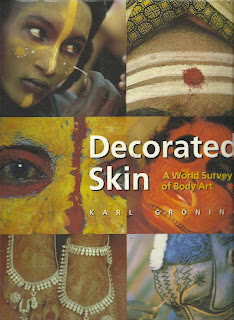Symbols of fulfilment, social values and ideals
Many African societies and tribes decorate themselves with striking scars, carefully incised to create beautiful patterns. The purpose and function of these markings can only be understood in context of the social background, they can denote a particular age group, or signify membership to a particular tribe. The main purpose of the scars is to appeal to the opposite sex, because a person is not viewed as an adult or ready for marriage without them. In some cultures people without visible scars are viewed as cowards or anti social.
The Kaleri women of Nigeria display and show off their scars proudly, making them attractive and desirable.
Lifelong markings: testimony to personal experience
Scarring in tribes are used in various ways and for different reasons. Scars are marks that document and record important stages in a persons life. For example the Nuba make incisions over the eyes to improve eyesight, while incisions in the temples are believed to relieve headaches.
The women of the Ga'anda in Nigeria go through a series of scarifications in eight stages extending across several years. From the age of around five the scars are incised on specific parts of the body in a particular order by experts, who are usually older women. When this programme of scarification is complete, the women are finally viewed as adult and eligible for marriage. The designs are know as hleeta.
The scars on the back of the Nuba woman below show that she has had at least one child.
Karo women in south-west Ethiopia have permanent scar patterns that indicate their age and status.
Attributes of recognition among the Mursi and the Bumi
The Mursi and the Bumi come from the Omo valley of south-west Ethiopia. The Omo valley groups are well known for the diversity of their decorative scars which ornament their faces and bodies.
The scars displayed on the arms and bodies of the Mursi are often a record of personal achievements, which can include feats of bravery in battle or outstanding skill in hunting. The marks improve the social status of the wearer.
Bumi men scar their faces and wear multicoloured decorations made from clay which are often adorned with feathers
Prescribed patterns and shades of colour: women's markings
The scarification of the Nuba women's bodies reflects their role in society and reflects their responsibilities. However it is not only scars that denote a woman's status. Only girls that have not yet been pregnant normally cover their entire bodies with a mixture of oil and ochre. A woman's hair is also shaved at the initial stage of pregnancy and is only allowed to grow back after birth.
To make the scars the skin is first raised with a thorn and then cut with a sharp blade, normally a sharp knife or a razor blade.
Luluwa: the marks of dignity, hope and vitality
Decorative scars are both aesthetic and symbolic for the Luluwa of Zaire.
The head and neck of this Luluwa motherhood figure are covered with a variety of decorative scars, denoting healthy and flawless skin and the particular psychological and physical qualities of the wearer.
Many African governments have now banned 'tribal-marks' and scarification denoting membership to a particular kinship. However even in the countries that it os banned it still continues in secret.
The fantastic 'uniforms' of the Nuba
In some south-eastern Nuba groups the colour of the body painting and hairstyles show a person's age group. The body painting is seen as a fine art and are only done by the most talented amongst the tribe, as the artistic decorations are to stand up to the scrutiny of a public that is only too ready to scorn and mock unsuccessful patterns and colour combinations.
Men in the same village will usually decorate themselves together, still no two patterns are the same. For the Nuba the hairstyle is very important, which rounds off the general impression. They even sleep with neck supports as to not crack and ruin the carefully constructed hairstyle.
Symbol of youth: Masai body decoration
Masai warriors from Kenya and Tanzania spend a long time painting their bodies, drawing patterns with their fingers while the paint is still wet. The paintings emphasize the health and fitness of the young male body. The patterns often symbolize deeds of heroism, for example a particularly successful hunt.
The end of the warrior phase of life is marked by the olngesherr ceremony, at which the young men are finally accepted into the ranks of the elders. Many Masai decorate themselves with blue and red face-paint for the ceremony.
White: a link with the supernatural
For many African tribes people, white symbolizes the link with the spirits of the ancestors and other supernatural beings. Elsewhere, or on different occasions it can also be a symbol for friendly and helpful spirits. In many societies white also has a purifying, healing and protective effect. The white colouring material is generally made from kaolin, light clay, flour or ground mussel shells.
Face painting is also an essential part of daily body care, and also serves as a protection from insects.
Different groups distinguish themselves from each other by means of their distinctive facial paint patterns.
Painted bodies, painted walls: living art forms amongst the Loma
For the Loma in Guinea it is only the women who paint their bodies, which is know as podai. Only black is used to paint the body, the pigment being made out of charcoal and oil from the podai tree. These body paintings are not only an aesthetic, they also mark the change from the natural state to the realm of culture. Once the colours are faded, the girls are then considered as adults within their tribe.
A young Samburu man in warrior's array.





















No comments:
Post a Comment